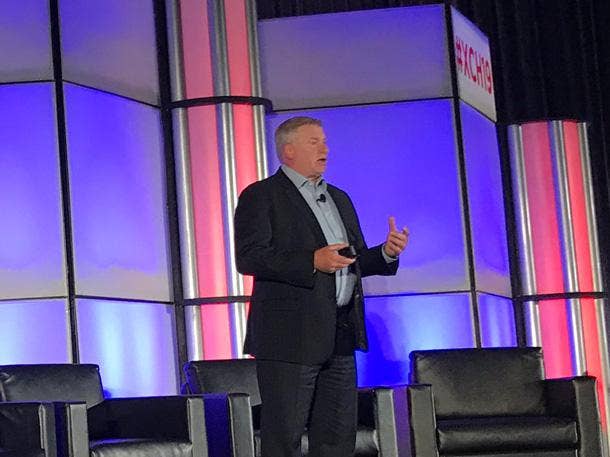Services-led Partners Driving Twice The Gross Margin Vs. Product-led Peers
‘All these big MSPs are starting to have two-thirds of their revenue being services-led because you double profitability compared to the traditional resale model,’ said Bob Skelley, CEO of The Channel Company at XChange 2019.

The Data Behind The Profits
Services-led solution providers are seeing more than twice the gross margin compared to their counterparts who are still mainly focused on reselling products, according to a new research by The Channel Company. Being a services-led solution provider is now the key ingredient to driving higher gross margins and stickiness with the customer.
“All of these big MSPs are starting to have two-thirds of their revenue being services-led because you double profitability compared to the traditional resale model,” said Bob Skelley, CEO of The Channel Company during XChange 2019.
The Channel Company’s IPED Consulting group conducted surveys of more than 500 solution providers along with dozens of qualitative interviews to on the state of partner profitability in 2019. The survey also delved into what services are driving the highest margins as well as solution providers’ biggest challenges and investments this year.
Here are the eight biggest findings in the eye-popping solution provider survey.

‘Bad Revenue’: Selling Too Much Product Can Hurt Valuation
There is a large industry shift occurring that is moving revenue from transactional to services-led, which isn’t too shocking, said Skelley. However, the rate and pace of this change is now accelerating faster than ever which can affect the valuation of a solution provider.
Although product sales drive revenues and create cash flow and funding to invest further in services, having too much product sales can hurt the valuation of a company. For example, one solution provider told the story of how a private equity firm warned his company that taking a multi-million product order would negatively impact the partner’s recurring revenue mix.
“A solution provider said, ‘If we get below 80 percent services, our private equity people will sit there and complain about a $3 million order because it shifts our revenue mix from 80 percent to 78 percent,’” said Skelley. “It’s a strange conversation to be having that there’s such a thing as bad revenue. So when you talk from a valuation standpoint, that topic can come up. Services are the main margin differentiator for them.”
Skelley said solution providers are looking to increase their percentage of services-led revenue as part of their overall revenue “because that drives valuation.” Blending professional services with services that are recurring, at scale, is the secret sauce, he said.

A Higher Service-Led Mix Translates To Higher Profits
The average gross margin for a solution provider is 22 percent if their total revenue is around 80 percent product resale and 20 percent services, the survey showed. That gross margin climbs to 28 percent when services account for 34 percent of total revenue with 59 percent being product resale. For a solution provider whose services sales account for 68 percent of total revenue, gross margins skyrockets to 45 percent.
“That 45 percent gross margin is more than double the 22 percent margin of the traditional model,” said Skelley. “The impact of your services mix versus resale mix drives gross margin profitability. … All of these big MSPs are starting to have two-thirds of their revenue being services-led because you double profitability compared to the traditional resale model.”

Recurring Revenues Drive Tangible Profit Differences
Within a solution provider’s services business, the percentage of recurring revenue has a material impact on the company’s gross profit margin.
For a product-led solution provider where 30 percent of services revenues are recurring, gross profit is 36 percent, according to the survey. That compares to a s ervice-led solution providers with 60 perent recurring revenue, with gross profit of 55 percent.
Skelley said the direct ties between recurring revenue and gross profit margin make it even more clear that solution providers need to shift their business to being services-led compared to reselling products if they want higher margins.
“This is a double effect. First, there’s an impact of services in general on profit margin. Then there’s the percentage of those services revenue that are recurring that has a material impact on the gross profit for your services business,” said Skelley.

Top Solutions Driving The Highest Margins
There are three different services categories that are driving the highest margins for solution providers in 2019. They revolve around professional deployment services, ongoing managed services and assessment services.
For professional deployment services, rich margins revolve around cloud migration, hybrid cloud and application migration. “Application migration is driving a tremendous amount of the margin and is the most intellectually-property-driven. It’s where the DevOps teams sits as well,” said Skelley. “Cloud data migration is becoming commoditized already and the margins on that aren’t nearly as good as AppDev, DevOps or application migration which is all about making those applications on-premises work properly in your cloud environment.”
Some of the highest margins for partners come from ongoing security services around advanced threat detection. Other highly profitable services include ongoing disaster recovery and business continuity solutions.
One interesting service that is driving margins for solutions providers is core and advanced security assessments. Skelley said assessment services is sometimes provided by solution providers free of charge, but that is changing.
“The more legacy business models tend to give assessment for free as a way to get into the customer. They use it as a door opener. The more progressive, advanced go-to-market models that are more managed services and cloud-based are always charging for it. It’s always a billable item in their proposals,” said Skelley. “That’s a really interesting philosophy. I think this is a big change.”

The Hottest And Coldest Types Of Services
Total services sales account for 65 percent of solution providers’ total revenue in 2019, up from only 48 percent in 2013, according to the survey.
“In a six year period, services revenue rose from 48 percent to now 65 percent -- that’s a pretty remarkable change,” said Skelley.
The two fastest growing services in the channel are managed services and cloud services. In terms of the percentage of services sales contributing to company’s overall revenue, managed services rose from 10 percent in 2013 to 29 percent in 2019. Cloud services increased from 4 percent in 2013 to 13 percent in 2019.
With the rapid demand for managed and cloud services, some services like on-premise hardware, on-premise software and project-based services are declining in terms of its portion in the company’s overall revenue.
On-premises hardware services dropped from 26 percent in 2013 to 21 percent in 2019. On-premises software services declined from 22 percent of overall revenue to 14 percent in the same six-year time period. Project-based services represent 23 percent of a solution providers’ total revenue in 2019, down from 34 percent in 2013.

Millennials Don’t Like Certifications
Solution providers anecdotally said there’s resistance among the younger workface to obtaining vendor certifications.
“They think it’s old-school, nobody wants to do it, they think it’s a waste of time,” said Skelley. “It’s not valued by the younger workforce. They said it takes them away from the things that are tied to their compensation. If they’re in a training class, they’re not out there doing billable hours.”
Additionally, the rate of technology change is so fast it’s making millennials hesitant to get certified. A specific IT certification can sometimes become obsolete within six to 18 months. However, with cloud vendors like Microsoft and Amazon Web Services increasing the pressure to get trained and certified on their offerings, solution provider executives still place a high value on certifications.
“Between the opportunity cost and rate of change, solution providers are really struggling with the training and certification piece, but they understand they have to make that investment,” said Skelley.

Staffing Is A Big Challenge
Solution providers are investing heavily to hire and retain the correct technical staff. Channel partners said one of the broadest challenges in the market is the increasing cost of labor and benefits.
One solution provider respondant said he is paying 125 percent of the market rate for technical talent as a retention strategy. “They said, ‘I pay 125 percent of market value for my technical staff. I had to build that in to reduce churn,” said Skelley. “Another said, ‘Seventy-five percent of my expense [Cost Of Goods Sold] is people. It’s increasingly hard to find the right people.’ This really underscores the staffing challenge.”
Additional staffing challenges in the channel include a retiring workforce and bench utilization for higher-priced roles. “Especially when you get down to the specialist vertically-focused roles, you have to have high utilization rates or else you’re not recouping your costs,” said Skelley.

Automation Investment On Rise
Solution providers are spending big time in 2019 on service automation tools in a move to automate as many core activities as possible. This type of investment is allowing partners to scale services practices at a faster pace compared to those who don’t leverage automation.
“If I’m completely relying on finding more technical talent to scale, then I can’t scale quick enough. The core has to be done around automation, then supplemented by staffing,” said Skelley.
Solution providers surveyed said ServiceNow and Salesforce are growing business opportunities as their core automation service to drive their business. “Especially the MSPs that have gone up market and are selling to the larger enterprises and scaling the business,” said Skelley. “The smaller solution providers are still bundling this up and looking at the ConnectWise’s of the world. But as they get to a certain size, they start to look at best of breed.”